A new study says the rates of literacy among ancient Israelites might be far higher than previously suspected.
A new study of inscriptions at Tel Arad, an ancient fort that was probably destroyed during the invasion of Babylonian King Nebuchadnezzar II, claims that at least a dozen different people left written records at the site in the late 7th century BC.
The handwriting samples – inscribed on pottery, known as ostraca, and dealing with mundane instructions of a military fort – have been of interest to scholars since they were discovered in the 1960’s.
The latest research – conducted by scholars at Duke University and Tel Aviv University and published Sept. 9 in PLOS ONE journal – used two new algorithmic handwriting analysis methods on the ostraca, as well as an independent analysis by a professional forensic document examiner.
“We examined the question of literacy empirically, from different directions of image processing and machine learning,” said Shira Faigenbaum-Golovin, one of the authors of the study.
“Among other things, these areas help us today with the identification, recognition, and analysis of handwriting, signatures, and so on. The big challenge was to adapt modern technologies to 2,600-year-old ostraca. With a lot of effort, we were able to produce two algorithms that could compare letters and answer the question of whether two given ostraca were written by two different people.”

A previous study published in 2016 identified six different author – itself enough to question the prevailing theory of a low level of literacy within the Kingdom of Judah, the successor state of the United Monarchy ruled over by the Biblical figures of Saul, David, and Solomon before splitting into the Kingdoms of Judah and Israel in the 10th century BC.
For decades, most scholars have proposed the absence of a literate population meant that earliest books of the Old Testament couldn’t have been written until at least the 6th century BC, when the First Temple was destroyed and the Israelites transported to Babylon for nearly 70 years before being allowed to return to the Holy Land and build the Second Temple by the Persian King Cyprus.
However, as evidence grows of widespread literacy in the Kingdom of Judah, it means it means the Old Testament could be far older.
“It should be remembered that this was a small outpost, one of a series of outposts on the southern border of the kingdom of Judah. Since we found at least 12 different authors out of 18 texts in total, we can conclude that there was a high level of literacy throughout the entire kingdom,” said Dr. Barak Sober.
“The commanding ranks and liaison officers at the outpost, and even the quartermaster Eliashib and his deputy, Nahum, were literate. Someone had to teach them how to read and write, so we must assume the existence of an appropriate educational system in Judah at the end of the First Temple period. This, of course, does not mean that there was almost universal literacy as there is today, but it seems that significant portions of the residents of the kingdom of Judah were literate,” he continued.
Sober said this is an important point when dating biblical texts.
“If there were only two or three people in the whole kingdom who could read and write, then it is unlikely that complex texts would have been composed,” he explained.
If more people could read and write in the Judahite kingdom, it also means the potential audience of the earlier Biblical texts widens.
“The unprecedented scribal activity during this era … provides a suitable literacy level and historical context for the composition and dissemination (including appreciation among the population) of several fundamental Judahite biblical texts. We refer mainly to the Book of Deuteronomy and to the first version of the consolidated narrative presented in the Books of Joshua, Judges, Samuel and Kings–the so-called Deuteronomistic History … These writings served as the law and ‘historical’ platforms aimed at advancing the Judahite ideology and theology … at the end of 7th–beginning of the 6th centuries BCE. Judging from archaeological data, the destruction of Jerusalem by Nebuchadnezzar in 586 BCE brought about decline if not cessation of this significant Hebrew literary activity in the southern highlands for the next four centuries,” the article in PLOS ONE argues.
Tel Aviv University’s Israel Finkelstein pointed out that the Biblical texts were written to promote the “ideological messages of the time,” not for people living 2,600 years later.
“It is important to ask who these texts were written for. According to one view, there were events in which the few people who could read and write stood before the illiterate public and read texts out to them. A high literacy rate in Judah puts things into a different light,” he said.
“Until now, the discussion of literacy in the kingdom of Judah has been based on circular arguments, on what is written within the Bible itself, for example on scribes in the kingdom. We have shifted the discussion to an empirical perspective. If in a remote place like Tel Arad there was, over a short period of time, a minimum of 12 authors of 18 inscriptions, out of the population of Judah which is estimated to have been no more than 120,000 people, it means that literacy was not the exclusive domain of a handful of royal scribes in Jerusalem. The quartermaster from the Tel Arad outpost also had the ability to read and appreciate them,” Finkelstein added.
















